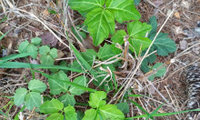Recent Activity
westmichiganflorafau commented on a discussion: what kind of buttercup?
Like 12 Comments
westmichiganflorafau likes a comment on a discussion: Is this elderberry?
Like 2 Comments

floraluk2
I'd say it's Sambucus racemosa, Red Elderberry.






IMHO, Cardamine diphylla seems to have much more serrated edges (these are rounded more like poison oak) and I would think at this time of year there would be flowers present to confirm it and C. diphylla doesn't seem to have the whitish leaf veins or the leathery look, but that's just a non-expert opinion. But I guess if davidrt28 handled the leaves he may already have his answer.
Maybe it is just plain old Toxicodendron radicans. Here in SW MI it can be extremely variable and even look similar to poison oak. Early spring leaves can even have that leathery/waxy look to them. However, those white/lite colored leaf veins and the very blunt/rounded leaf tips are unusual, the closest thing I have saved is in these photos.
According to the USDA "Atlantic" poison oak (Toxicodendron pubescens) isn't found in MI:
https://plants.usda.gov/home/plantProfile?symbol=TOPU2
Of course that doesn't mean that it is totally impossible to find it outside of the map seen there.
Eastern Poison Oak, Toxicodendron pubescens can have both rounded or sharp cut leaflet lobes. The terminal petiolule is much longer, and the leaves and stems are puberulant giving it a felty appearance.
Toxicodendron pubescens.
Toxicodendron pubescens.
I knew the petiole didn't look right from the start, but thought maybe it was a Rhus, because it also resembles Rhus aromatica Lol. Brassicaceae didn't jump into my mind. Looks like it could be something in Vitaceae also. Cardamine has such a wide diversity of leaf shapes and variations. The local species hirsuta and concatennata are instantly recognizable, but I've never encountered diphylla.